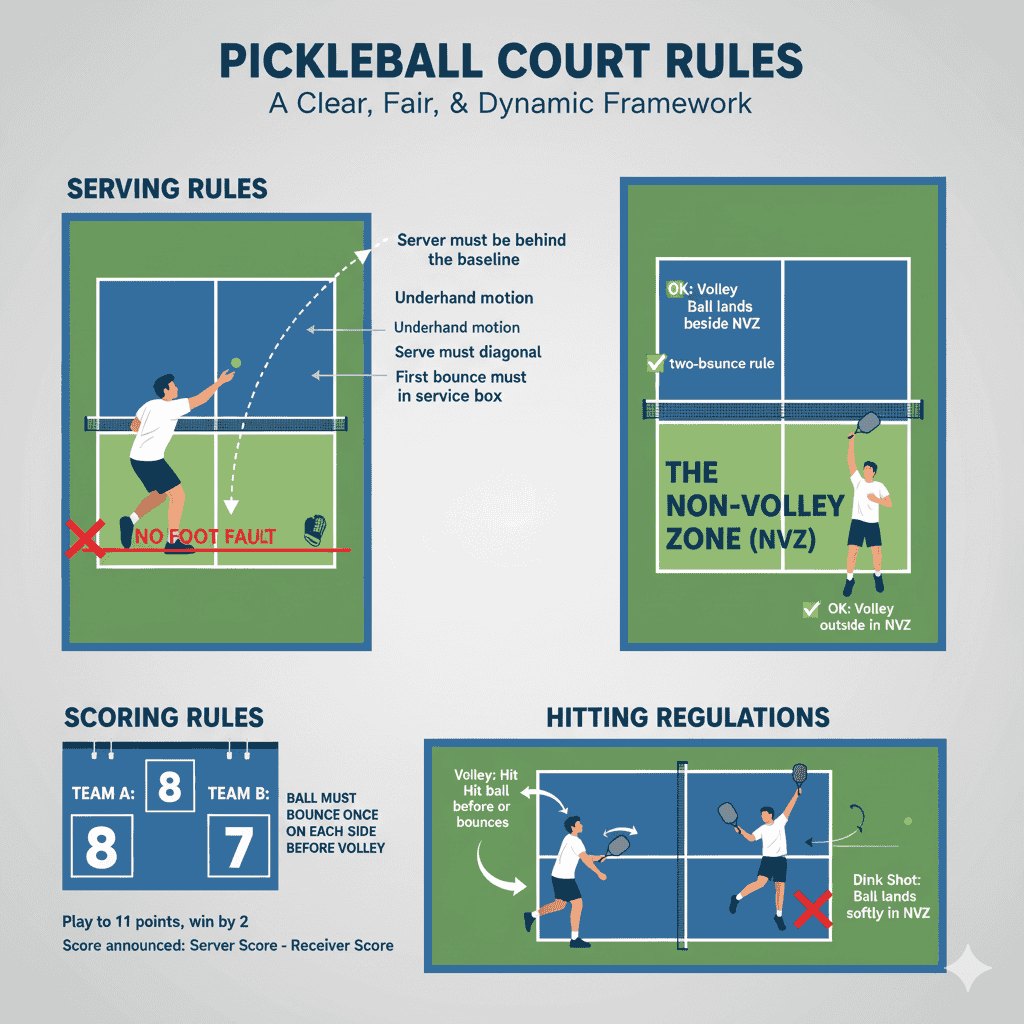Pickleball Court Rules
Pickleball Court Rules: Establishing a Clear, Fair, and Dynamic Framework for Competition
On a Pickleball court, the rules act like the rails of a fast-moving train—guiding every rally, ensuring fairness, and maintaining the sport’s unique rhythm and excitement.
Knowing and following these rules is essential for every player stepping onto the court, and it is also the cornerstone that keeps Pickleball thriving with energy and competitive charm.
I. Serving Rules: The Starting Signal of Every Rally
Serving is more than just putting the ball in play—it is the official launch of every point, and therefore governed by precise requirements.
The server must stand behind the baseline with both feet entirely outside the court. Even a slight foot fault—stepping on the line or leaning over—will nullify the serve. This maintains absolute fairness from the very beginning of each rally.
One of the most defining features of Pickleball is the underhand serve rule.
The ball must be struck with an upward arc and directed diagonally into the opponent’s service box. The served ball must bounce once before the receiver may return it. While the underhand motion may appear gentle, it requires great skill. Servers must manage speed, angle, spin, and height to keep opponents guessing. A fast, low serve limits reaction time, while a serve with spin can cause unpredictable bounces and disrupt the receiver’s timing. The player who masters these variations can immediately take control of the point.
II. Scoring Rules: The Numeric Pulse of the Match
Pickleball employs a straightforward yet strategic scoring system.
Only the serving side can score. Winning a rally as the server earns a point, while losing the rally results in a turnover of service rather than a point for the opponent. This heightens the competitive tension—servers strive to take full advantage of their scoring opportunity, while receivers work aggressively to break serve.
A game is typically played to 11 points, and the winner must lead by at least 2 points.
This rule keeps matches competitive and prevents early, anticlimactic endings. When the score reaches 10-10, the game enters a dramatic “win by two” phase, in which every shot carries enormous weight. Even a trailing player can stage a comeback, adding suspense and emotional highs to the match.
III. Hitting Regulations: Core Standards for Fair Play
The rules governing ball contact form the backbone of Pickleball competition.
Players may only strike the ball with their paddle—touching the ball with the body or clothing counts as a fault. The ball may bounce only once before it must be returned, and players must react quickly, judge timing precisely, and adjust their swing angle instantly.
Players also have the option to hit the ball before it bounces, known as a volley.
Volleys can be powerful tools for gaining an advantage, allowing players to take time away from their opponents. However, volleying requires sharper reflexes and immediate judgment, as there is no bounce to slow the ball.
Regardless of technique, every shot must land within the opponent’s valid court. Even a slight overhit results in losing the rally.
This means players must balance aggression with precision, shaping shots that pressure opponents while staying safely within the court boundaries.
IV. The Non-Volley Zone (NVZ): Maintaining Balance and Fair Play
The non-volley zone—often referred to as the “Kitchen”—is one of Pickleball’s most distinctive rules.
Extending several feet from both sides of the net, the NVZ prevents players from hitting volleys while standing inside this area. When contacting the ball in this zone, both feet must be entirely outside the NVZ.
This rule prevents overly aggressive net play and preserves a healthy balance between offense and defense.
When the ball lands inside the NVZ, players must choose soft, controlled shots such as dinks or gentle drops that safely clear the net. When the ball is outside the zone, players can quickly step forward to attack with volleys or smashes. Mastering this dynamic—moving in and out of the zone with purpose—is essential for high-level Pickleball strategy.
Conclusion
From serving mechanics to scoring, shot rules, and the non-volley zone, Pickleball’s court rules establish a structured, fair, and deeply strategic environment.
Whether you're a professional competitor or a casual player, understanding and respecting these rules allows you to truly showcase your skill, creativity, and sportsmanship. Together, these principles create the vibrant, thrilling, and fast-growing world of Pickleball that players around the globe love.

BHI Pickleball-Custom pickleball paddle






